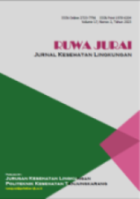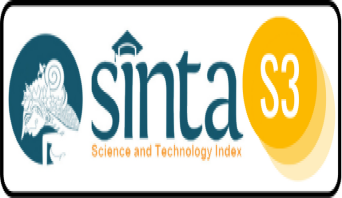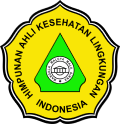The Influence of Institutional and Regulatory Aspects and Information on Waste Management on Community Intention to Support Waste Management in the Kahayan River Basin, Central Kalimantan
DOI:
https://doi.org/10.26630/rj.v19i1.4691Keywords:
Kahayan River Basin, Domestic Waste, Behavior, Information, InstitutionsAbstract
Disposing of domestic waste into the river remains a common practice among the majority of residents along the Kahayan River in Palangka Raya City impacting pollution, flooding, and public health. This study aims to analyze variables influencing people's intention to support domestic waste management activities. The study was conducted in Mendawai and Flamboyan Bawah, densely populated settlements on the banks of the Kahayan River in Palangka Raya City. One hundred respondents were selected with a non-probability technique and interviewed to obtain information on infrastructure (X1), economy (X2), location (X3), institutions and regulations (X4), and waste management information (X5) aspects. Descriptive statistics was utilized to understand respondent characteristics and Structural Equation Model-Partial Least Square (SEM-PLS) was applied to determine the effect of each variable. This study found that the majority of respondents were women (n = 44), housewives (n = 40), and over 35 years old (n = 46). The analysis results show that increasing the information aspect of waste management will increase the community's intention to support domestic waste management activities by 40.1% (P = 0.001). Meanwhile, increasing the institutional and regulatory aspects has an effect of 29.2% (P = 0.002). The other three variables did not show significant results (P > 0.05). The results of this study reveal that the community's intention to support domestic waste management activities is influenced by the informational, institutional and regulatory aspects. Establishing community-based institutions that able to provide ongoing support presents a viable strategy for promoting sustainable behavioral change.
References
Angriani, P., Sumarmi, Ruja, I. N., & Bachri, S. (2018). River management: The importance of the roles of the public sector and community in river preservation in Banjarmasin (A case study of the Kuin River, Banjarmasin, South Kalimantan – Indonesia). Sustainable Cities and Society, 43, 11–20. https://doi.org/10.1016/j.scs.2018.08.004
Asteria, D., & Heruman, H. (2016). Bank Sampah Sebagai Alternatif Strategi Pengelolaan Sampah Berbasis Masyarakat di Tasikmalaya. Jurnal Manusia Dan Lingkungan, 23(1), 136. https://doi.org/10.22146/jml.18783
Astoeti, D. D., Gumiri, S., Neneng, L., & Ardianoor. (2021). Relationship between water quality, sanitation and hygiene on environmental health of community settled on Kahayan River Bank, Palangka Raya. IOP Conference Series: Earth and Environmental Science, 886(1), 012067. https://doi.org/10.1088/1755-1315/886/1/012067
Bakri, S., & Yushananta, P. (2023). Water Pollution and Water Quality Assessment of the Way Kuripan River in Bandar Lampung City (Sumatera, Indonesia). Polish Journal of Environmental Studies, 32(2), 1061–1070. https://doi.org/10.15244/pjoes/153432
Budhi, S. (2018). Analisis Statistik Multivariate Dengan Aplikasi SEM PLS SMARTPLS 3.2.6 (Pertama). Expert.
Cao, M., Hu, A., Gad, M., Adyari, B., Qin, D., Zhang, L., Sun, Q., & Yu, C.-P. (2022). Domestic wastewater causes nitrate pollution in an agricultural watershed, China. Science of The Total Environment, 823, 153680. https://doi.org/10.1016/j.scitotenv.2022.153680
Celik, E., Aydin, N., & Gumus, A. T. (2014). A multiattribute customer satisfaction evaluation approach for rail transit network: A real case study for Istanbul, Turkey. Transport Policy, 36, 283–293. https://doi.org/10.1016/j.tranpol.2014.09.005
Darwin, M., Mamondol, M. R., Sormin, S. A., Nurhayati, Y., Tambunan, H., Sylvia, D., Adnyana, M. D. M., Prasetyo, B., Vianitati, P., & Antonius Adolf Gebang. (2021). Metode Penelitian Pendekatan Kuantitatif Kualitatif (T. S. Tambunan (Ed.); Issue June). Media Sains Indonesia.
Gifford, M., Chester, M., Hristovski, K., & Westerhoff, P. (2018). Human health tradeoffs in wellhead drinking water treatment: Comparing exposure reduction to embedded life cycle risks. Water Research, 128, 246–254. https://doi.org/10.1016/j.watres.2017.10.014
Gu, P., & Ma, X. (2013). Investigation and analysis of a floating population’s settlement intention and environmental concerns: A case study in the Shawan River Basin in Shenzhen, China. Habitat International, 39, 170–178. https://doi.org/10.1016/j.habitatint.2012.12.005
Kock, N. (2019). WarpPLS User Manual: Version 6.0. ScriptWarp Systems TM.
Kospa, H. S. D. (2018). Kajian Persepsi dan Perilaku Masyarakat Terhadap Air Sungai. Jurnal Tekno Global UIGM Fakultas Teknik, 7(1). https://doi.org/10.36982/jtg.v7i1.509
Mahyudin, R. P. (2017). Kajian Permasalahan Pengelolaan Sampah dan Dampak Lingkungan di TPA (Tempat Pemrosesan Akhir). Jukung (Jurnal Teknik Lingkungan), 3(1), 66–74. https://doi.org/10.20527/jukung.v3i1.3201
Martiyani, E., Jaksa, S., Ernyasih, E., & Andriyani, A. (2023). Faktor-Faktor yang Berhubungan dengan Pengelolaan Sampah pada Pedagang di Pasar Sepatan Kabupaten Tangerang Tahun 2022. Environmental Occupational Health And Safety Journal, 3(2), 125. https://doi.org/10.24853/eohjs.3.2.125-140
Mas’ulatul Janah, F. (2021). Kajian Persepsi Masyarakat tentang Pengelolaan Sampah di Hilir Daerah Aliran Sungai Brantas. Environmental Pollution Journal, 1(2), 110–118. https://doi.org/10.58954/epj.v1i2.13
Mawardi, Y. I., Dhokhikah, Y., & Listyawati, R. N. (2022). Kajian Pengelolaan Sampah Berbasis Masyarakat di Desa Gucialit, Kecamatan Gucialit, Kabupaten Lumajang. Matrapolis: Jurnal Perencanaan Wilayah Dan Kota, 3(1), 09. https://doi.org/10.19184/matrapolis.v4i1.34534
Novrianti, N. (2016). Pengaruh Aktivitas Masyarakat di pinggir Sungai (Rumah Terapung) terhadap Pencemaran Lingkungan Sungai Kahayan Kota Palangka Raya Kalimantan Tengah. Media Ilmiah Teknik Lingkungan, 1(2), 35–39. https://doi.org/10.33084/mitl.v1i2.144
Rimandani, Lubis, S. N., & Charloq. (2023). Perencanaan Pengembangan Pengelolaan Sampah di Bantaran Sungai Alas Desa Kutacane Lama Kabupaten Aceh Tenggara. Jurnal Intervensi Sosial Dan Pembangunan (JISP), 4(1), 1–8. https://doi.org/10.30596/jisp.v4i1.13019
Setyawati, E. Y., & Priyo Siswanto, R. S. H. (2020). Partisipasi Perempuan Dalam Pengelolaan Sampah Yang Bernilai Ekonomi dan Berbasis Kearifan Lokal. JAMBURA GEO EDUCATION JOURNAL, 1(2), 55–65. https://doi.org/10.34312/jgej.v1i2.6899
Sholihah, K. K. A., & Hariyanto, B. (2020). Kajian Tentang Pengelolaan Sampah di Indonesia. Swara Bumi, 3(3), 1–9. https://ejournal.unesa.ac.id/index.php/swara-bhumi/article/view/35038
Tiaraningrum, N. B. P., & Pratama, Y. (2022). Peran Serta Masyarakat dalam Pengelolaan Sampah Rumah Tangga di Bantaran Sungai Cikapundung Kelurahan Maleer. Jurnal Serambi Engineering, 7(4), 3984–3993. https://doi.org/10.32672/jse.v7i4.4883
Triyani, T., & Syarpin, S. (2022). Pemberdayaan masyarakat Daerah Aliran Sungai (DAS) Kahayan di Kelurahan Palangka Kota Palangka Raya melalui program Ecoliteracy. Unri Conference Series: Community Engagement, 4, 78–85. https://doi.org/https://doi.org/10.31258/unricsce.4.78-85
Widiyanto, A. F., Zeha, H. N., Rahardjo, S., & Suratman, S. (2020). Faktor-Faktor yang Berpengaruh terhadap Praktik Masyarakat dalam Pengelolaan Sampah di Desa Ketenger, Kecamatan Baturaden, Kabupaten Banyumas. Jurnal Kesehatan Lingkungan Indonesia, 19(2), 76–81. https://doi.org/10.14710/jkli.19.2.76-81
Wikipedia. (2024). Sungai Kahayan. In Wikipedia. https://id.wikipedia.org/wiki/Sungai_Kahayan
Yulida, N., Suwarni, A., & Sarto, S. (2016). Analysis of community behavior on garbage disposing in Batang Bakarek-Karek river basin of Padang Panjang. Berita Kedokteran Masyarakat, 32(10), 373. https://doi.org/10.22146/bkm.7298
Downloads
Published
How to Cite
Issue
Section
License
Copyright (c) 2025 Ruwa Jurai: Jurnal Kesehatan Lingkungan

This work is licensed under a Creative Commons Attribution-NonCommercial 4.0 International License.

Ruwa Jurai: Jurnal Kesehatan Lingkungan is licensed under a Creative Commons Attribution-NonCommercial 4.0 International License.
Authors who publish with this journal agree to the following terms:
- Authors retain copyright and grant the journal right of first publication with the work simultaneously licensed under a Creative Commons Attribution-Non Commercial License that allows others to share the work with an acknowledgment of the work's authorship and initial publication in this journal.
- Authors are able to enter into separate, additional contractual arrangements for the non-exclusive distribution of the journal's published version of the work (e.g., post it to an institutional repository or publish it in a book), with an acknowledgment of its initial publication in this journal.
- Authors are permitted and encouraged to post their work online (e.g., in institutional repositories or on their website) prior to and during the submission process, as it can lead to productive exchanges, as well as earlier and greater citation of published work.









